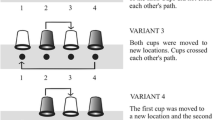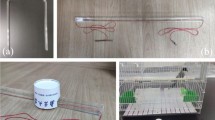Abstract
Cotton top tamarins were tested in visible and invisible displacement tasks in a method similar to that used elsewhere to test squirrel monkeys and orangutans. All subjects performed at levels significantly above chance on visible (n=8) and invisible (n=7) displacements, wherein the tasks included tests of the perseverance error, tests of memory in double and triple displacements, and "catch" trials that tested for the use of the experimenter's hand as a cue for the correct cup. Performance on all nine tasks was significantly higher than chance level selection of cups, and tasks using visible displacements generated more accurate performance than tasks using invisible displacements. Performance was not accounted for by a practice effect based on exposure to successive tasks. Results suggest that tamarins possess stage 6 object permanence capabilities, and that in a situation involving brief exposure to tasks and foraging opportunities, tracking objects' movements and responding more flexibly are abilities expressed readily by the tamarins.


Similar content being viewed by others
Notes
The switch from task 1 to task 2 was made to occur within one session, so that the tendency to repeat the prior visited location would be salient. If a session was ended at the end of task 1, the next session began with three trials of task 1 before task 2 was initiated.
References
Baillargeon R (1995) Physical reasoning in infancy. In: Gazzaniga M (ed) The cognitive neurosciences. MIT Press, Cambridge, Mass., pp 181–204
Call J (2000) Representing space and objects in monkeys and apes. Cogn Sci 24:397–422
Call J (2001) Object permanence in orangutans (Pongo pygmaeus), chimpanzees (Pan troglodytes), and children (Homo sapiens). J Comp Psychol 115:159–171
de Blois ST, Novak MA (1994) Object permanence in rhesus monkeys (Macaca mulatta). J Comp Psychol 108:318–327
de Blois ST, Novak MA, Bond M (1998) Object permanence in orangutans (Pongo pygmaeus) and squirrel monkeys (Saimiri sciureus). J Comp Psychol 112:137–152
de Blois ST, Novak MA, Bond M (1999) Can memory requirements account for species' differences in invisible displacement tasks? J Exp Psychol Anim Behav Process 25:168–176
Diamond A (1988) Differences between adult and infant cognition: is the crucial variable presence or absence of language? In: Weiskrantz L (ed) Thought without language. Clarendon Press, Oxford, pp 337–370
Diamond A (1991) Neuropsychological insights into the meaning of object concept development. In: Carey S, Gelman R (eds) The epigenesis of mind: essays on biology and cognition. Erlbaum, Hillsdale, N.J., pp 67–110
Doré FY (1986) Object permanence in adult cats (Felis catus). J Comp Psychol 100:340–347
Doré FY (1990) Search behavior in cats (Felis catus) in an invisible displacement test: cognition and experience. Can J Psychol 44:359–370
Dumas C (1992) Object permanence in cats (Felis catus): an ecological approach to the study of invisible displacements. J Comp Psychol 106:404–410
Dumas C, Brunet C (1994) Permanence de l'objet chez le singe capucin (Cebus apella): etude des deplacements invisibles [Object permanence in capuchin monkeys (Cebus apella): a study of invisible displacements]. Can J Exp Psychol 48:341–357
Dumas C, Doré FY (1989) Cognitive development in kittens (Felis catus): a cross-sectional study of object permanence. J Comp Psychol 103:191–200
Dumas C, Doré FY (1991) Cognitive development in kittens (Felis catus): an observational study of object permanence and sensorimotor intelligence. J Comp Psychol 105:357–365
Dumas C, Wilkie DW (1995) Object permanence in ring doves (Streptopelia risoria). J Comp Psychol 2:142–150
Etienne AS (1984) The meaning of object permanence at different zoological levels. Hum Dev 27:309–320
Gagnon S, Doré FY (1992) Search behavior in various breeds of adult dogs (Canis familiaris): object permanence and olfactory cues. J Comp Psychol 106:58–68
Gagnon S, Doré FY (1993) Search behavior of dogs (Canis familiaris) in invisible displacement problems. Anim Learn Behav 21:246–254
Gagnon S, Doré FY (1994) A cross-sectional study of object permanence in domestic puppies (Canis familiaris). J Comp Psychol 108:220–232
Goulet S, Doré FY, Rousseau R (1994) Object permanence and working memory in cats (Felis catus). J Exp Psychol Anim Behav Process 20:347–365
Hauser MD (1997) Artifactual kinds and functional design features: what a primate understands without language. Cognition 64:285–308
Hauser MD (2000) Wild minds: what animals really think. Holt, New York
Hauser MD (2001) Searching for food in the wild: a nonhuman primate's expectations about invisible displacement. Dev Sci 4:84–93
Hauser MD, Kralik J, Botto C, Garrett J, Oser J (1995) Self-recognition in primates: phylogeny and the salience of species-typical traits. Proc Natl Acad Sci U S A 92:10811–10814
Hauser MD, Kralik J, Botto-Mahan C (1999) Problem solving and functional design features: experiments with cotton-top tamarins. Anim Behav 57:565–582
Hauser MD, Williams T, Kralik JD, Moskovitz D (2001) What guides a search for food that has disappeared? Experiments on cotton-top tamarins (Saguinus oedipus). J Comp Psychol 115:140–151
Hood BM, Cole-Davies V, Dias M (2003) Looking and search measures of object knowledge in preschool children. Dev Psychol 39:61–70
Mathieu M, Bergeron G (1981) Piagetian assessment of cognitive development in chimpanzee (Pan troglodytes). In: Chiarelli AB, Corruccini RS (eds) Primate behavior and sociobiology. Springer, Berlin Heidelberg New York, pp 142–147
Mathieu M, Bouchard MA, Granger L, Herscovitch J (1976) Piagetian object permanence in Cebus capucinus, Lagothrica flavicauda, and Pan troglodytes. Anim Behav 24:585–588
Milton K (1988) Foraging behaviour and the evolution of primate intelligence. In: Byrne RW, Whiten A (eds) Machiavellian intelligence. Social expertise and the evolution of intellect in monkeys, apes, and humans. Oxford University Press, New York, pp 285–305
Natale F, Antinucci F (1989) Stage 6 object-concept and representation. In: Antinucci F (ed) Cognitive structure and development in nonhuman primates. Erlbaum, Hillsdale, N.J., pp 97–112
Natale F, Antinucci F, Spinozzi G, Potí P (1986) Stage 6 object concept in nonhuman primate cognition: a comparison between gorilla (Gorilla gorilla gorilla) and Japanese macaque (Macaca fuscata). J Comp Psychol 100:335–339
Neiworth JJ, Anders SL, Parsons RR (2001) Tracking responses related to self-recognition: a frequency comparison of responses to mirrors, photographs, and videotape of monkeys by cotton top tamarins (Saguinus oedipus). J Comp Psychol 115:432–438
Neiworth JJ, Burman MA, Basile BM, Lickteig MT (2002) Use of experimenter-given cues in visual co-orienting and in an object-choice task by a new world monkey species, cotton top tamarins (Saguinus oedipus). J Comp Psychol 116:3–11
Pepperberg IM (2002) The value of the Piagetian framework for comparative cognitive studies. Anim Cogn 5:177–182
Pepperberg IM, Kozak FA (1986) Object permanence in the African grey parrot (Psittacus erithacus). Anim Learn Behav 14:322–330
Pepperberg IM, Willner MR, Gravits LB (1997) Development of Piagetian object permanence in a grey parrot (Psittacus erithacus). J Comp Psychol 111:63–75
Piaget J (1952) The origins of intelligence in children. (Cook M, trans) International Universities Press, New York (Original work published 1936)
Piaget J (1954) The construction of reality in the child. (Cook M, trans) Basic Books, New York
Redshaw M (1978) Cognitive development in human and gorilla infants. J Hum Evol 7:133–141
Schino G, Spinozzi G, Berlinguer L (1990) Object concept and mental representation in Cebus apella and Macaca fascicularis. Primates 31:537–544
Spinozzi G, Natale F (1989) Early sensorimotor development in gorilla. In: Antinucci F (ed) Cognitive structure and development in nonhuman primates. Erlbaum, Hillsdale, N.J., pp 21–38
Tomasello M, Call J (1997) Primate cognition. Oxford University Press, New York
Triana E, Pasnak R (1981) Object permanence in cats and dogs. Anim Learn Behav 9:135–139
Vaughter RM, Smotherman W, Ordy JM (1972) Development of object permanence in the infant squirrel monkey. Dev Psychol 7:34–38
Watson JS, Gergely G, Csanyi V, Topal J, Gacsi M, Sarkozi Z (2001) Distinguishing logic from association in the solution of an invisible displacement task by children and dogs: using negation of disjunction. J Comp Psychol 115:219–226
Wise KL, Wise LA, Zimmermann RR (1974) Piagetian object permanence in the infant rhesus monkey. Dev Psychol 10:429–437
Wood S, Moriarty KM, Gardner BT, Gardner RA (1980) Object permanence in child and chimpanzee. Anim Learn Behav 8:3–9
Acknowledgements
The authors would like to thank Charles Snowdon, PhD, University of Wisconsin-Madison, for the generous gift of animals to Carleton College, to Carleton College, and to the Howard Hughes Medical Institute for its support of this project, and to the editor and the anonymous reviewers for their thoughtful comments. The experiment reported herein complies with the standards for care and research in the United States, as described by USDA and PHS, and was approved by the College's institutional animal care and use committee.
Author information
Authors and Affiliations
Corresponding author
Rights and permissions
About this article
Cite this article
Neiworth, J.J., Steinmark, E., Basile, B.M. et al. A test of object permanence in a new-world monkey species, cotton top tamarins (Saguinus oedipus). Anim Cogn 6, 27–37 (2003). https://doi.org/10.1007/s10071-003-0162-2
Received:
Revised:
Accepted:
Published:
Issue Date:
DOI: https://doi.org/10.1007/s10071-003-0162-2




